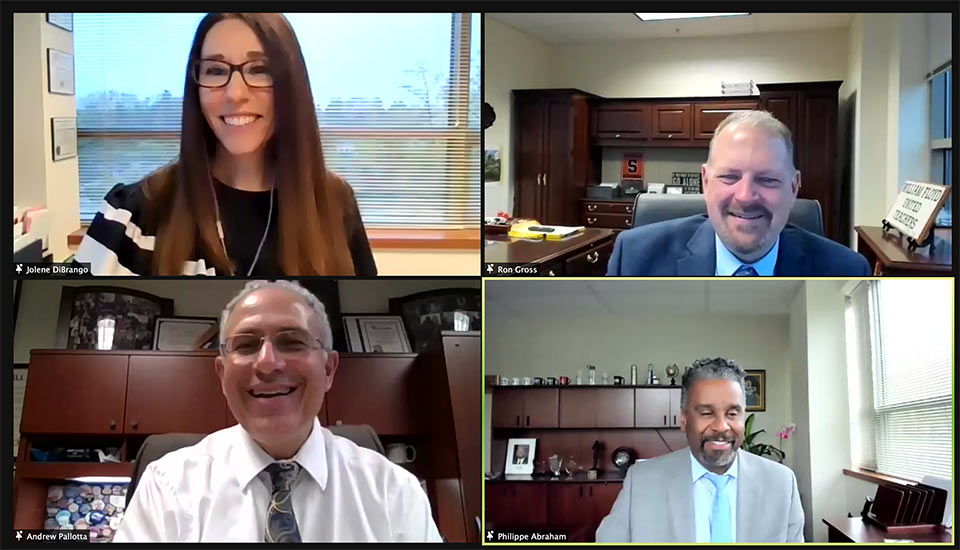NYSUT members around the state say the pandemic experiment in concurrent teaching should not continue into the next school year — or become the new normal.
The message was loud and clear from hundreds of local union presidents who came together online Thursday night for the annual Local and Retiree Council Presidents Conference that precedes NYSUT’s Representative Assembly.
“Simultaneously engaging with students remotely and in your classroom is nothing short of impossible,” said John Caulfield of Levittown United Teachers during a breakout dialogue with the NYSUT officers.
Teaching in two modalities at the same time “is horrible for our children,” said Regina McLean, Port Washington Teachers Association.
“We need the State Education Department to set up guard rails,” said NYSUT President Andy Pallotta. “Let’s not have an a la carte way of teaching. That is not productive. It causes nothing but anxiety.”
“We feel simultaneous teaching is bad practice and bad pedagogy,” said NYSUT Executive Vice President Jolene DiBrango. “It’s not a good use of technology.”
During a Q&A session with State Education Commissioner Betty Rosa and Regents Chancellor Lester Young, DiBrango asked about lessons learned during the pandemic and the role of remote instruction.
“In-person learning can never be replaced … the human connection is critical,” Rosa said. “A platform can be used to expand, to enhance — but never to replace.”
Young said it’s critical for educators to use the lessons from the pandemic to “build a new possible” for all of New York’s students. He said the pandemic underscored the vast inequities of the educational system — and he is hopeful the new state and federal funding will help target those inequities and negative impacts of the pandemic.
“We are in an incredible moral moment,” Young said, urging educators to work with their local school districts to address issues surrounding diversity, equity and inclusion.

After the Q&A session with the commissioner and chancellor, NYSUT’s four statewide officers circulated among small breakout sessions with hundreds of local union leaders who brought thanks, questions and suggestions.
Melissa Servant of the Wallkill TA asked what NYSUT could do to help members deal with health and safety on the job. NYSUT Second Vice President Ronald Gross — who oversees the union’s health and safety programs — noted the issue has been a challenge statewide, especially as COVID-19 protocols continuously change. He encouraged leaders to have their locals represented at NYSUT’s Health & Safety Conference in late May. He also urged locals to work with their district administrations to use federal funds to establish testing programs and update building ventilation systems.
“Some of us have buildings 100 years old,” said Lynbrook TA’s Craig Kirchenberg, “Some ventilation systems are so antiquated the stimulus money doesn’t even come close to updating the ventilation systems.”
“Start with buildings that need it the most,” Gross said. “The pandemic shed light on how important the ventilation systems are, more than mold ever did.”
Terry Kalb, president of RC 22, expressed concern that kids will be over tested when traditional education resumes to measure so-called learning loss. “What they’ve really lost is going outside, visiting museums, field trips … just being together in a classroom, with emphasis on play and socialization,” he said.
“We cannot keep saying ‘You’re behind. You’re behind,’” DiBrango agreed. “We need to wrap our arms around them” and use trauma-informed practice and social-emotional learning.
JoAnn Signorelli of North Bellmore TA called for a big push to hire more mental health professionals “We have two social workers for five buildings,” she said. NYSUT Legislative Director Alithia Rodriguez-Rolon said NYSUT-backed bills would require a social worker, nurse, psychologist and school counselor in every building.
In other legislative initiatives, Pallotta assured leaders that NYSUT continues to advocate for an early retirement incentive. Another key end-of-session bill would suspend Annual Professional Performance Reviews for this year and preserve a path for teachers to earn tenure.
On NYSUT’s anti-racism efforts, Cordelia Anthony of Farmingdale Federation of Teachers said social justice is not a primary concern in some districts. NYSUT Secretary-Treasurer J. Philippe Abraham said NYSUT won $1 million in the state budget for implicit bias training for school staff. “We all have biases,” Abraham said. “It’s what we do about them, and how they impact others.”
Abraham also noted the May 12 Civil and Human Rights Committee meeting will be open to NYSUT members; the topic is addressing hatred toward Asians.
Andre Mathis of Union-Endicott Office Personnel Association, suggested NYSUT expand its Take a Look at Teaching initiative to create career ladder opportunities for School-Related Professionals. This would not only help SRP members, it would also be an effective way to diversify the teaching work force, Mathis said.
“Please don’t forget about (improving diversity in) higher education,” said Roberta Elins, president of the United College Employees of the Fashion Institute of Technology. “Though our colleges have a large percentage of students of color, they can go two to four years without seeing a professor who looks like them.”
DiBrango said a recent NEA grant would help NYSUT work with local unions to create Grow Your Own programs for SRPs and partnerships among K-12, higher education and community groups.
Dave Lamouret of Cherry Valley-Springfield TA, noted many leaders are at the end of their careers and local unions have struggled to provide leadership training due to the pandemic. “We hope to get back to in-person leadership conferences and training in the fall,” Gross said. “We switched over to a virtual format but we know we can’t replace the camaraderie and networking of doing it in person.”